Page 145 of 207

Fuel
144
FuelPetrolGrades of petrolYour vehicle can only be operated with unleaded petrol, which complies with the
standard EN 228. The individual grades of petrol are distinguished by their octane
number (RON). On the inside of the fuel filler flap, you will find the information
regarding the RON required by your engine page 145, fig. 141 .
Prescribed fuel - unleaded petrol 95/91 RON
Use unleaded petrol 95 RON. You can also use unleaded petrol 91 RON, but this leads
to a slight loss in performance.
If, in case of necessity, the vehicle must be refuelled with petrol of a lower octane
number than the one prescribed, you must co ntinue driving at medium engine speeds
and low engine load. Driving at high engine speeds or a high engine load can severely
damage the engine! Refuel as soon as possib le with petrol of the prescribed octane
number.
Prescribed fuel - unleaded petrol min. 95 RON
Use unleaded petrol 95 RON.
In case of necessity, you can refuel with petrol 91 RON if petrol 95 RON is not avail-
able. You must continue driving at medium engine speeds and minimum engine load.
Driving at high engine speeds or a high engine load can severely damage the engine!
Refuel as soon as possib le with petrol of the prescribed octane number.
Even in case of necessity, you must not use petrol of a lower octane number than 91,
otherwise the engine can be severely damaged!
You can find further information on refuelling page 145.
Unleaded petrol with higher octane number
You can make unlimited use of unleaded pe trol which has a higher octane number
than the one prescribed. On vehicles with prescribed unleaded petrol
95/91 RON, the use of petrol with a
higher octane number than 95 does not result in a noticeable power increase or a
lower fuel consumption.
On vehicles with prescribed unleaded petrol min. 95 RON, the use of petrol with a
higher octane number than 95 does not result in a power increase or a lower fuel
consumption.
Caution
All Škoda vehicles with petrol engines are equipped with a catalytic converter and
must be only driven with unleaded petrol. Fi lling the tank even only once with leaded
petrol will result in the cata lytic converter being destroyed!
Only use unleaded petrol which complies with the standard EN 228.
If you use petrol with a lower octane num ber than the one prescribed, the engine
can be severely damaged!Note
The handling, performance and life of your engine are determined to a significant
extent by the quality of the fuel. Do not use any petrol additives.DieselDiesel fuelYour vehicle can only be operated with diesel fuel, which complies with the standard
EN 590 (standard DIN 51628 in Germany, standard ÖNORM C 1590 in Austria).
Fuel additives
You must not use fuel additives, so-called “flow improvers” (petrol and similar prod-
ucts) in diesel fuel.
You can find information on refuelling page 145.
s2rc.book Page 144 Thursday, April 22, 2010 10:58 AM
Page 146 of 207

Fuel145
Using the system
Safety
Driving Tips
General Maintenance
Breakdown assistance
Technical Data
Caution
Therefore, your vehicle can only be operated with diesel fuel which complies with
the standard EN 590 (standard DIN 51628 in Germany, standard ÖNORM C 1590 in
Austria). Filling the tank even only once wi th diesel fuel which does not comply with
the standard, can result in damage to the engine parts, the lubrication system, the fuel
and exhaust system.
If by mistake you have refuelled with a different fuel other than the diesel fuel
which complies to the above mentioned standards (e.g. petrol), do not start the engine
or switch on the ignition! This can result in severe engine damage! Contact a specialist
garage and have the fuel sy stem of the engine cleaned.
Water which has collected in the fuel fi lter can result in engine problems.
Your vehicle is not adapted for use of biofue l (RME), therefore this fuel must not be
refuelled and driven. The use of biofuel (RME) can lead to damage to the engine or the
fuel system.
Operation in winterWinter-grade diesel fuel
A different grade of diesel fuel is available at filling stations in winter than during the
summer. Using “summer-grade diesel fuel” at temperatures below 0°C can result in
operational problems because th e diesel becomes viscous as a result of paraffin sepa-
ration.
It is therefore the case that EN 590 prescribes diesel fuel class for certain periods of the
year which can also be purchased at the co rresponding time during the year. “Winter-
grade diesel fuel” will still operate properly even at a temperature of -20°C.
It is often the case in countries with different climatic conditions that diesel fuels avail-
able have a different temperature characteri stic. The specialist garages and the filling
stations in the country co ncerned will be able to pr ovide you with information
regarding the diesel fuels available.
Prewarming fuel
The vehicle is fitted with a fuel filter prewarming system. This secures operation of a
vehicle using diesel fuel down to an environmental temperature of -25°C.
Caution
It is not permitted to add the various fuel additives on the market, including petrol, to
diesel fuel in order to improve its flow properties.RefuellingThe filler tube of the fuel reservoir is locate d in the rear right side part of the vehicle.Opening the fuel filler cap– Open the fuel filler flap with the hand.
– On vehicles without remote unlocking of the fuel filler flap from the driver's seat,
unlock the fuel filler cap on the fuel filler tube by turning the vehicle key to the left.
Fig. 140 Switch for opening the
fuel filler flap from the driver
seatFig. 141 Fuel filler flap with cap
unscrewed
s2rc.book Page 145 Thursday, April 22, 2010 10:58 AM
Page 147 of 207
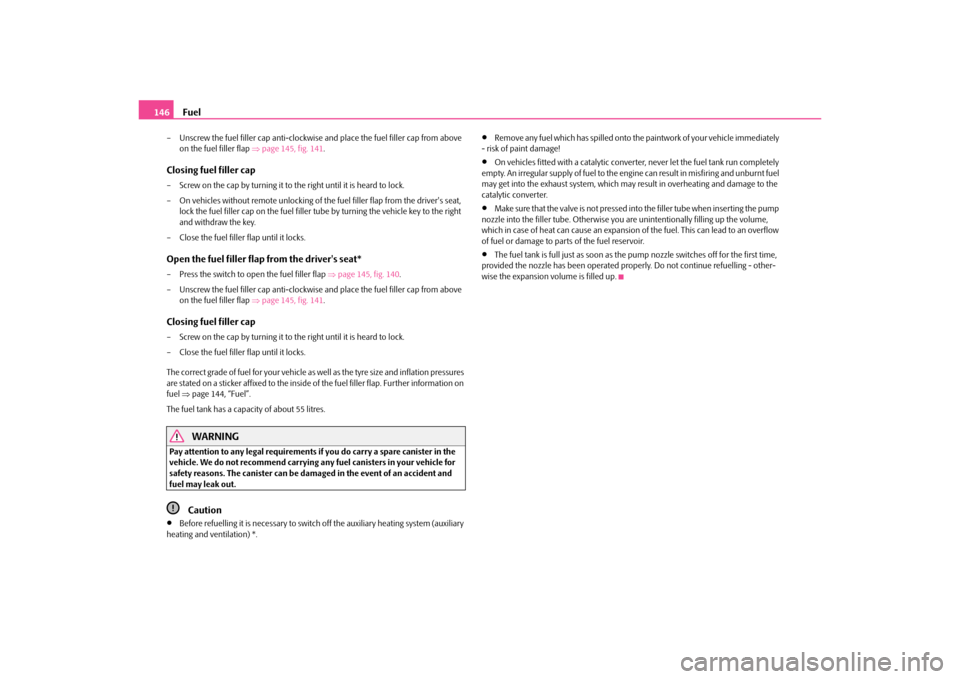
Fuel
146
– Unscrew the fuel filler cap anti-clockwise and place the fuel filler cap from above
on the fuel filler flap page 145, fig. 141 .Closing fuel filler cap– Screw on the cap by turning it to the right until it is heard to lock.
– On vehicles without remote unlocking of the fuel filler flap from the driver's seat,
lock the fuel filler cap on the fuel filler tube by turning the vehicle key to the right
and withdraw the key.
– Close the fuel filler flap until it locks.Open the fuel filler flap from the driver's seat*– Press the switch to open the fuel filler flap page 145, fig. 140 .
– Unscrew the fuel filler cap anti-clockwise and place the fuel filler cap from above
on the fuel filler flap page 145, fig. 141 .Closing fuel filler cap– Screw on the cap by turning it to the right until it is heard to lock.
– Close the fuel filler flap until it locks.
The correct grade of fuel for your vehicle as well as the tyre size and inflation pressures
are stated on a sticker affixed to the inside of the fuel filler flap. Further information on
fuel page 144, “Fuel”.
The fuel tank has a capa city of about 55 litres.
WARNING
Pay attention to any legal requirements if you do carry a spare canister in the
vehicle. We do not recommend carrying any fuel canisters in your vehicle for
safety reasons. The canister can be da maged in the event of an accident and
fuel may leak out.
Caution
Before refuelling it is necessary to switch off the auxiliary heating system (auxiliary
heating and ventilation) *.
Remove any fuel which has spilled onto th e paintwork of your vehicle immediately
- risk of paint damage!
On vehicles fitted with a ca talytic converter, never let th e fuel tank run completely
empty. An irregular supply of fuel to the engine can result in misfiring and unburnt fuel
may get into the exhaust system, which may result in overheating and damage to the
catalytic converter.
Make sure that the valve is not pressed into the filler tube when inserting the pump
nozzle into the filler tube. Otherwise you are unintentionally filling up the volume,
which in case of heat can caus e an expansion of the fuel. This can lead to an overflow
of fuel or damage to parts of the fuel reservoir.
The fuel tank is full just as soon as the pump nozzle switches off for the first time,
provided the nozzle has been operated properly. Do not continue refuelling - other-
wise the expansion volume is filled up.
s2rc.book Page 146 Thursday, April 22, 2010 10:58 AM
Page 148 of 207

Inspecting and replenishing147
Using the system
Safety
Driving Tips
General Maintenance
Breakdown assistance
Technical Data
Inspecting and replenishingEngine compartmentBonnet remote releaseBonnet remote release– Pull the unlocking lever below the dash panel on the driver's side fig. 142 .
The bonnet jumps out of its lock as a result of the spring force.
Note
Ensure that the windscreen wiper arms are not folded out before opening the bonnet
otherwise damage could occur to the paintwork.
Opening and closing the bonnet.Opening the bonnet– Unlock the bonnet fig. 142 .
– Grip with the hand under the radiator grille and lift up the bonnet.
– Press the locking lever in direction of arrow fig. 143 and lift up the bonnet.
– Take the bonnet support out of its holder and set it in the opening designed for it fig. 144 .
Fig. 142 Bonnet release lever
Fig. 143 Radiator grille: Locking
leverFig. 144 Securing the bonnet
with the bonnet support
s2rc.book Page 147 Thursday, April 22, 2010 10:58 AM
Page 149 of 207

Inspecting and replenishing
148
Closing the bonnet
– Lift the bonnet slightly and unhook the bonnet support. Press the bonnet support
into the holder designed to hold it.
– Allow the bonnet to drop from a height of about 30 cm into the lock - bonnet do
not press down on it !
WARNING
Never open the bonnet if you see that steam or coolant is flowing out of the
engine compartment - risk of scalding! Wait long enough until the steam or
coolant has stopped escaping.
For safety reasons, the bonnet must always be properly closed when
driving. One should therefore check that the lock has in fact engaged properly
after closing the bonnet.
Stop your vehicle immediately while drivin g if you notice that the lock is not
properly engaged and close the bonnet properly - risk of an accident!
Working in the engine compartment
Particular care is required when carrying out any work in the engine
compartment!There is a risk of injuries, scalding, acci dents and fire when working in the engine
compartment, e.g. inspecting and replenishing oil and other fluids. For this
reason, it is essential to comply with the warning instructions stated below and
with the general applicable rules of safe ty. The engine compartment of your car
is a hazardous area .
WARNING
Never open the bonnet if you see that steam or coolant is flowing out of the
engine compartment - risk of scalding! Wait long enough until the steam or
coolant has stopped escaping.
Switch off the engine and pull out the ignition key.
Apply the handbrake firmly.
On vehicles fitted with a manual gea rbox, move the gearshift lever into
Neutral.
Allow the engine to cool down.
Keep children clear of the engine compartment.
Never spill oil and other fluids over the hot engine. Such fluids (e.g. the anti-
freeze contained in the coolant) may ignite!
Avoid short circuits in the electrical system - particularly on the battery.
Never place your hand into the radiator fan as long as the engine is still
warm. The fan might suddenly start running!
Never open the cap of the coolant expans ion bottle as long as the engine is
still warm. The cooling system is pressurized!
Cover over the cap of the coolant expansion reservoir with a large cloth
when opening it as protection for your face, hands and arms from hot steam or
hot coolant.
Do not let objects, such as e.g cleaning cloth or tools lie in the engine
compartment.
If you wish to work under the vehicl e, you must secure the vehicle from
rolling away and support it with suitable supporting blocks; the lifting jack* is
not sufficient for this - risk of injury!
In cases where it be necessary to carry out inspection work when the engine
is running there is an additional risk fr om rotating parts (e.g. the V-ribbed belt,
alternator, radiator fan) and from the high-voltage ignition system. Please
observe in addition the following:
Never touch the electrical cabl es of the ignition system.
Absolutely avoid any jewellery, loose it ems of clothing or long hair from
getting into the rotating parts of the engine - Hazard! Therefore remove any
jewellery beforehand, tie up your hair and wear tight fitting clothing.
Please also comply with the warnin g instructions stated below when
carrying out any essential work on the fu el system or on the electrical system:
Always separate the car battery from the electrical system.
Do not smoke.WARNING (continued)
s2rc.book Page 148 Thursday, April 22, 2010 10:58 AM
Page 150 of 207

Inspecting and replenishing149
Using the system
Safety
Driving Tips
General Maintenance
Breakdown assistance
Technical Data
Never carry out any work close to naked flames.
Always keep a working fire extinguisher at hand.
Caution
When replenishing fluids in the engine, always ensure that the fluids are on no account
mixed up. This may result in major oper ating problems and also vehicle damage!Overview of the engine compartment
The main inspection pointsFig. 145 1.6 ltr./75 kW petrol engine1.6 ltr./75 kW petrol engine fig. 145
Coolant expansion bottle . . . . . . . . . . . . . . . . . . . . . . . . . . . . . . . . . . . . . . .
Reservoir for hydraulic liquid of power steering Windshield washer fluid reservoir . . . . . . . . . . . . . . . . . . . . . . . . . . . . . . .
Engine oil dipstick . . . . . . . . . . . . . . . . . . . . . . . . . . . . . . . . . . . . . . . . . . . . . .
Engine oil filler opening . . . . . . . . . . . . . . . . . . . . . . . . . . . . . . . . . . . . . . . . .
Brake fluid reservoir . . . . . . . . . . . . . . . . . . . . . . . . . . . . . . . . . . . . . . . . . . . .
Battery (below a cover) . . . . . . . . . . . . . . . . . . . . . . . . . . . . . . . . . . . . . . . . .
Note
The location of the inspection points in th
e engine compartment of petrol and diesel
engines is practically identical.Engine oilEngine oil specificationsThe engine of your vehicle ha s been factory-filled with a high-grade oil which you can
use throughout the year - except in extreme climatic regions.
You can mix various oils together with each ot her when refilling with oil. This does not,
however, apply for models with flexible service intervals (QG1).
Engine oils are, of course, undergoing co ntinuous further development. Thus the
information stated in this Owner's Manual is only correct at the time of publication.
Authorised Škoda Service Partners are informed by Škoda Auto about current changes.
This why you should always have engine oi l changed by an authorised Škoda Service
Par tner.
The specifications (VW standards) stated in the following must be indicated separately
or together with other specifications on the bottle.
Engine oil specifications for models with flexible service intervals (QG1)
WARNING (continued)
A1
153
A2
Petrol engines
Specification
Content
a)
1.4 ltr./55 kW - EU4
VW 503 00, VW 504 00
3,2
1.6 ltr./75 kW - EU4/EU2 DDK
VW 503 00, VW 504 00
4,5
1.8 ltr./110 kW - EU4/EU3D
VW 504 00
4,5
A3
159
A4
150
A5
151
A6
154
A7
155
s2rc.book Page 149 Thursday, April 22, 2010 10:58 AM
Page 151 of 207

Inspecting and replenishing
150
Engine oil specifications for vehicles with fixed service intervals (QG2)
If the oils specified above are not available, oils according to ACEA A2 or ACEA A3 can
be used once for refilling.
If the oils specified above are not available, oils according to ACEA B3 or ACEA B4 can
be used once for refilling.
Caution
Only the above-mentioned oils may be used on vehicles with flexible service intervals
(QG1). We recommend always refilling with oil of the same specification since this will
maintain the properties of the oil. In exce ptional cases, you must top up only once
engine oil complying with Specification VW 502 00 (only for petrol engines) or Specifi-
cation VW 505 01 (only for diesel engines) to maximum 0.5 litres. You must not use
other engine oils - risk of engine damage!
Note
Before a long drive we recommend that you purchase and carry with you engine
oil which complies with the specification for your vehicle. Consequently, you will
always have the correct engine oil for refilling.
We recommend using a preservative from the Škoda original accessories offered
by your Škoda dealer.
For further information - see Service shedule.
Check engine oil level
The dipstick indicates the le vel of oil in the engine.Checking the oil level– Ensure that the vehicle is po sitioned on a level surface.
– Switch the engine off.
– Open the bonnet in “Working in the engine compartment” on page 148.
– Wait a few minutes and pull out the oil dipstick .
– Wipe off the dipstick with a clea n cloth and insert it again fully.
– Then withdraw the dipstick again and read off the oil level.Oil level within range –You must not top up the oil.
a)Oil capacity with oil filter change. Inspect oil leve l when filling; do not fill up too much. The oil
level must be between the markings page 150, fig. 146 .Diesel engines
Specification
Content
a)
1.9 ltr./74 kW TDI PD - EU4
VW 506 01, VW 508 00
4,3
Petrol engines
Specification
Content
a)
a)Oil capacity with oil filter change. Inspect oil leve l when filling; do not fill up too much. The oil
level must be between the markings fig. 146 .1.4 ltr./55 kW - EU4
VW 501 01, VW 502 00
3,2
1.6 ltr./75 kW - EU4/EU2 DDK
VW 501 01, VW 502 00
4,5
1.8 ltr./110 kW - EU4/EU3D
VW 502 00
4,5
Diesel engines
Specification
Content
a)
1.9 ltr./74 kW TDI PD - EU4
VW 506 01
4,3
Fig. 146 Dipstick
A1
Aa
s2rc.book Page 150 Thursday, April 22, 2010 10:58 AM
Page 152 of 207

Inspecting and replenishing151
Using the system
Safety
Driving Tips
General Maintenance
Breakdown assistance
Technical Data
Oil level within range –You may top up the oil. It is possible that the oil level may then be within range
after doing this.Oil level within range –You must top up the oil page 151. It is sufficient, once this is done, to keep the
oil level within range .
It is normal for the engine to consume oil. The oil consumption may be as much as 0.5
l/1 000 km depending on your style of driving and the conditions under which you
operate your vehicle. The oil consumption may be slightly hi gher than this during the
first 5 000 kilometres.
One should therefore check the oil level at regular intervals, preferably every time after
the fuel tank is filled or after driving for long stretches.
We recommend maintaining the oil level within the range if the engine has been
operating at high loads, for example during a lengthy motorway trip during the
summer months, towing a trailer or negotiating a high mountain pass, but not above
this .
The warning light in the instrument cluster wi ll indicate whether the oil level is too low
page 29. In this case, check the oil level as soon as possible. Top up with an appro-
priate quantity of oil.
Caution
The oil level must on no ac count extend beyond the range . Danger of damaging
the catalytic converter.
Do not continue your journey if for some reason it is not possible under the
conditions prevailing to top up with oil. Switch the engine off and obtain professional
assistance from a specialist garage, otherwise it could lead to severe engine damage.
Replenishing engine oil– Inspecting the engine oil level page 150.
– Unscrew the cap of the engine oil filler opening page 150, fig. 146 .
– Pour in a suitable grade of oil in portions of 0.5 litres page 149. – Inspect the oil level
page 150.
– Carefully screw on the cap of the filler opening and push the dipstick in fully.
WARNING
Avoid dripping oil onto hot parts of the engine when topping up will oil - a
risk of fire!
Read and observe the warning notes page 148, “Working in the engine
compartment” before working in the engine compartment.For the sake of the environment
The oil level must on no account be above the range page 150. Oil will otherwise
be drawn in through the cr ankcase ventilation and may pass through the exhaust
system to atmosphere. The oil may combust in the catalytic converter and damage it.Changing engine oilThe engine oil must be changed at the intervals stated in the Service schedule or
according to the service interval indicator page 18.
WARNING
Only carry out the engine oil change, if you have the required professional
knowledge!
Read and observe the warning notes page 148, “Working in the engine
compartment” before working in the engine compartment.
Let the engine cool down - risk of burning from hot oil.
Wear an eye protection - risk of caustic burns due to oil splashes.
Oil is toxic! Store old oil in a safe place out of the reach of children and unau-
thorized persons until you dispose of it properly.Caution
You must not pour any additives into the engine oil - risk of engine damage! Damage,
which results from such product, are excluded from the warranty.
Ab
Aa
AcAb
AaAa
A2
Aa
s2rc.book Page 151 Thursday, April 22, 2010 10:58 AM
 1
1 2
2 3
3 4
4 5
5 6
6 7
7 8
8 9
9 10
10 11
11 12
12 13
13 14
14 15
15 16
16 17
17 18
18 19
19 20
20 21
21 22
22 23
23 24
24 25
25 26
26 27
27 28
28 29
29 30
30 31
31 32
32 33
33 34
34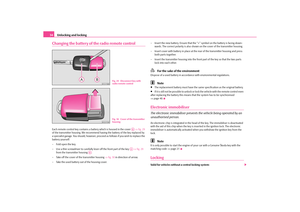 35
35 36
36 37
37 38
38 39
39 40
40 41
41 42
42 43
43 44
44 45
45 46
46 47
47 48
48 49
49 50
50 51
51 52
52 53
53 54
54 55
55 56
56 57
57 58
58 59
59 60
60 61
61 62
62 63
63 64
64 65
65 66
66 67
67 68
68 69
69 70
70 71
71 72
72 73
73 74
74 75
75 76
76 77
77 78
78 79
79 80
80 81
81 82
82 83
83 84
84 85
85 86
86 87
87 88
88 89
89 90
90 91
91 92
92 93
93 94
94 95
95 96
96 97
97 98
98 99
99 100
100 101
101 102
102 103
103 104
104 105
105 106
106 107
107 108
108 109
109 110
110 111
111 112
112 113
113 114
114 115
115 116
116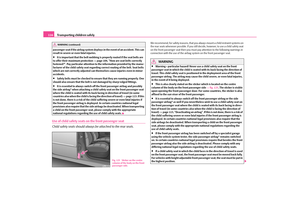 117
117 118
118 119
119 120
120 121
121 122
122 123
123 124
124 125
125 126
126 127
127 128
128 129
129 130
130 131
131 132
132 133
133 134
134 135
135 136
136 137
137 138
138 139
139 140
140 141
141 142
142 143
143 144
144 145
145 146
146 147
147 148
148 149
149 150
150 151
151 152
152 153
153 154
154 155
155 156
156 157
157 158
158 159
159 160
160 161
161 162
162 163
163 164
164 165
165 166
166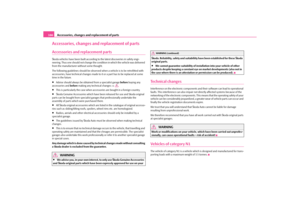 167
167 168
168 169
169 170
170 171
171 172
172 173
173 174
174 175
175 176
176 177
177 178
178 179
179 180
180 181
181 182
182 183
183 184
184 185
185 186
186 187
187 188
188 189
189 190
190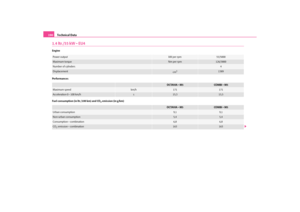 191
191 192
192 193
193 194
194 195
195 196
196 197
197 198
198 199
199 200
200 201
201 202
202 203
203 204
204 205
205 206
206






